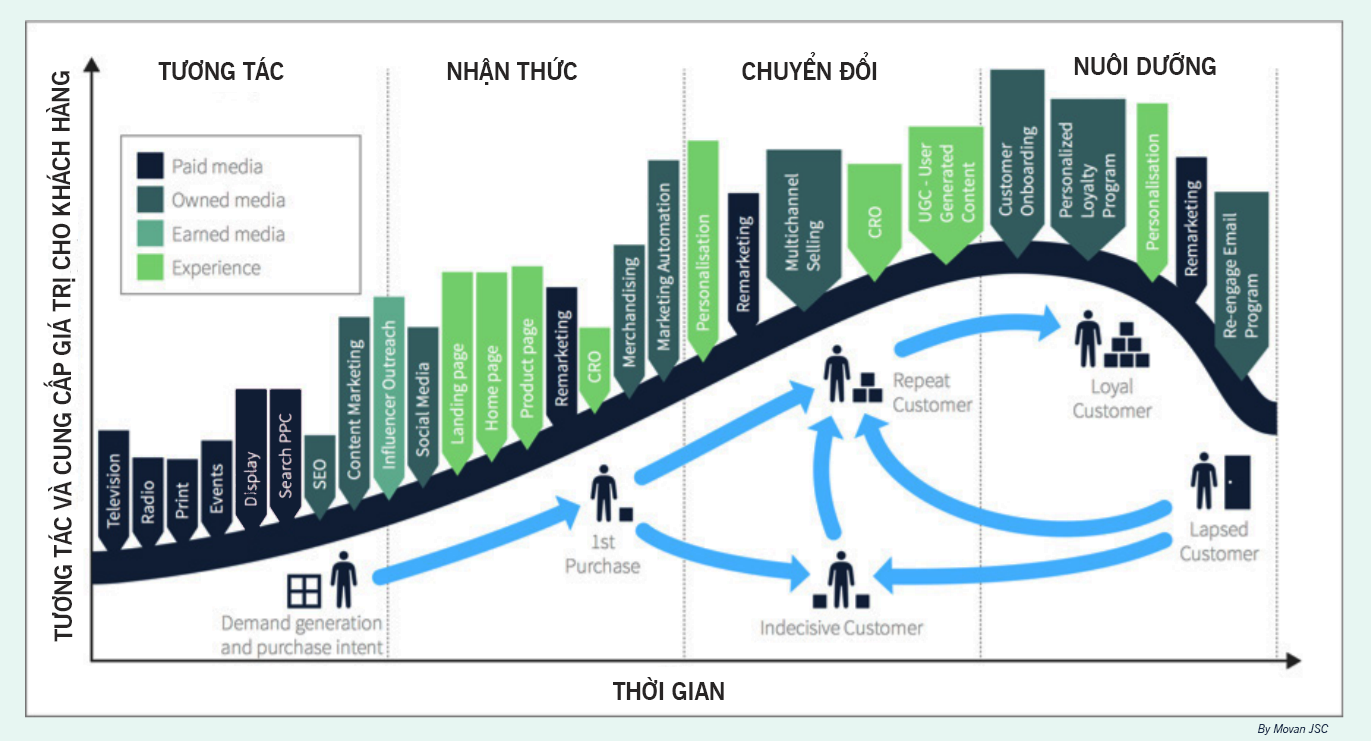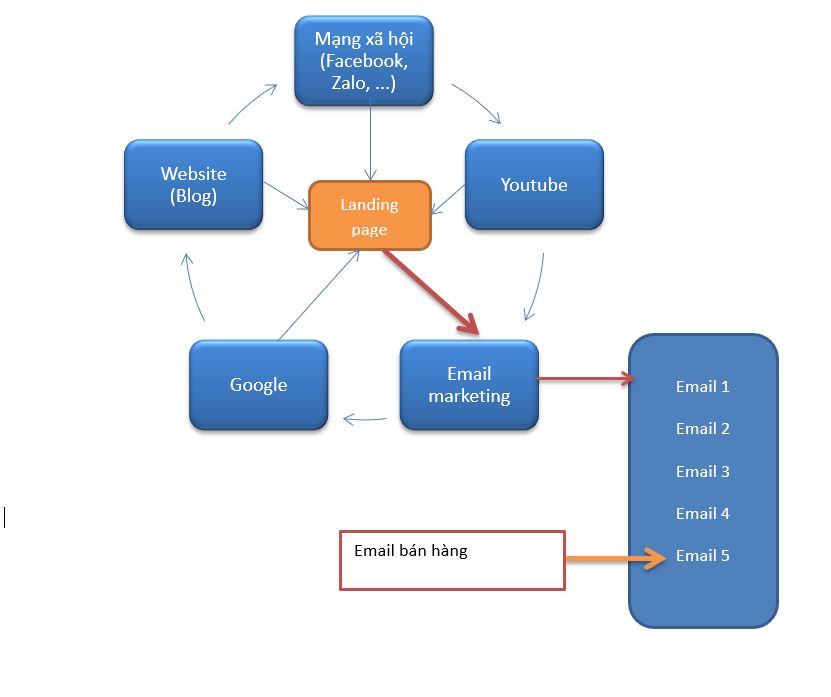Để có nhiều khách hàng trên Internet? Đây là câu hỏi mà rất nhiều người kinh doanh online muốn trả lời. Chúng ta cùng tìm hiểu nhé, tôi và bạn cùng chia sẻ về hình ảnh thú vị này để hình dung

Trục tung: là các kênh tương tác và giá trị cung cấp cho khách hàng, trục hoành: là mốc thời gian
Tìm hiểu 4 kênh với 4 màu sắc:
1. Trả tiền(Paid Media): Television, Radio, Print, Events. Khách hàng nhận biết qua cá kênh Outside Marketing để biết đến thương hiệu sản phẩm/dịch vụ của bạn
2. Kênh sở hữu (Owned Media): SEO, Content Marketing. Kênh này tại sao lại là sở hữu, vì kênh này chạy bằng cơm. Có thể tăng hoặc giảm theo chủ nhân :D, đặc biệt nó rất bền bỉ và đóng vai trò khá quan trọng trong vai trò tương tác với khách hàng. Nếu website của bạn không xuất hiện trên google search thì bạn đã bỏ qua một kênh tốt
3. Kênh truyền thông lan truyền (Earned media): Influencer Outreach, Seading
,Viral Marketing. Earned media có thể được xem như là kết quả của Paid media và Owned media, vì qua hai kênh truyền thông này, đối tượng của chiến dịch marketing mới được biết tới và khi khách hàng tự tạo ra những thảo luận về nó, Earned media được hình thành.
4. Kênh trải nghiệm (Experience): Kênh này đặc thù theo biểu đồ bên dưới khách hàng đã tương tác với bên bạn rồi thì cần kênh để dẫn đến “Chốt Sale” Thì những Landing Page, Home Page, Trang sản phẩm, CRO, Trình diễn mới phát huy tác dụng.
Nếu bạn làm marketing mà phi thẳng đến kênh này luôn tôi tin rằng bạn sẽ phải phụ thuộc nhiều vào quảng cáo, hết tiền quảng cáo là đơn không nổ. Hơn nữa nếu bạn coi nhẹ việc làm Branding mà đến luôn kênh này, có lẽ mô hình kinh doanh bạn đang có vấn đề cực lớn.
Đáng lạ là rất nhiều người mới kinh doanh online, nhất là người mới tập kinh doanh trên facebook gặp phải lỗi chết người này 🙁
Tìm hiểu 6 dạng chuyển đổi khách hàng:
1. Demand generation and purchase intent: Tạo nhu cầu và mục đích mua hàng
2. 1st Purchase: Khách hàng mua lần 1 (lần đầu tiên mua hàng)
3. Repeat Custommer: Khách hàng mua lại, mua thêm
4. Loyal Custommer: Khách hàng giới thiệu khách hàng khác, bắt tay với khách hàng
5. indecisive customer: khách hàng thiếu quyết đoán
6. Lapsed customer:Mất khách hàng
Để tạo ra 1st Purchase: Khách hàng mua lần 1 (lần đầu tiên mua hàng)
Tại hành trình này nấc thang được nâng cấp tăng cường mức độ tương tác với khách hàng, như là Landing Page, Remarketing,CRO, Marketing Automation
Tiếp đến để khách hàng mua lại nhiều lần (Repeat Custommer: Khách hàng mua lại, mua thêm) chúng ta tiếp tục Remarketing, đa kênh bán hàng, content nuôi dưỡng cung cấp giá trị cao dần
Để có được sự giới thiệu thêm khách hàng mới từ khách hàng cũ (Loyal Custommer): Tạo các chính sách cho đối tác, cá nhân hóa chăm sóc khách hàng, Tiếp tục Remarketing.
Để tránh việc khách hàng rời bỏ, hoặc khách hàng mua một lần thiếu quyết đoán ta phải chuyển khách hàng sang pha “Chuyển đổi” và họ sẽ nhận được chiến dịch marketing như chúng ta mong muốn.
Những con số thuyết phục:
Plan – create a long-term roadmap for growth based on the opportunity
1. Market potential. E-commerce sales account for just 8% of total retail sales in the US and 14% in the UK – so still lots of room for growth! (Source: Census.gov and Office of National Statistics).
2. Market potential. 53% of global internet users have made an online purchase in 2016- approx that’s 1 billion. (Source: US Government)
3. Market potential. B2B eCommerce sales are expected to outgrow B2C sales, reaching 6.7 trillion USD by 2020. (Source: CMS connected)
4. Market potential. Total average eCommerce spend per customer over the course of the year is estimated to be $1,800 in the US and 1,600 in the UK. (Source: Statista)
5. Marketing Technology. The availability of marketing tools for e-commerce has exploded – over 3,500 different types of MarTech on the market in 2016. (Source: Scott Brinker)
6. Consumer insight. 40% of US males aged 18-34 say they would ‘ideally buy everything online, compared to 33% of females in the same age bracket. (Source: DDB Worldwide)
Reach your audience – increase site visits, build awareness
7. Traffic sources. The top 3 traffic sources driving sales for Ecommerce sites (last click) are Organic (22%), Email (20%) and CPC (19%). Display and social account for just 1 and 2% showing the importance of measuring these using attribution. Source: Custora.
8. Traffic sources. 43% of e-commerce traffic comes from Google search (organic) and 26% comes from Google Adwords. (Source: Wolfgang digital)
9. SEO. 1 in 5 searches on US android mobile app are voice searches – Does your e-commerce SEO strategy reflect this? (Source: Google)
10. Social media. 55% of US Pinterest users use it for finding products (Source: KPCB Internet Trends)
Act – encourage interaction with product information and basket adds and email subs
11. Online behaviour. 39% of people will stop engaging with a website if it takes too long to load(Source: Adobe)
12. Online behaviour. 38% of people will leave a website if they find the layout unattractive. (Source: Adobe)
13.Online behaviour. 400 pixels from the left edge is the area of desktop site viewing which gets the most viewing time according to eye tracking surveys. (Source: Nielson Norman Group)
14. Marketing Automation. 49% of high performing marketing teams are using predictive analytics to inform their approach to the customer journey. (Source: Salesforce State of Marketing research)
15. Multichannel behaviour. 81% of shoppers research their product online before purchasing (Source: GE Shopper research study)
16. Multichannel behaviour. Only 11% of users access the Internet via desktop only – almost all users are using multiple devices (Source: comScore)
17. Consumer insight. 61% of high performing marketing are actively mapping the customer journey, compared to 22% of averagely performing teams and 6% of underperforming teams. (Source: Salesforce Research)
See our Persona toolkit for the best techniques for mapping the customer journey.
18. Consumer insight. Mobile sessions accounted for 59% of all sessions by device on eCommerce sites, but these mobile browsers made up just 38% of revenue (Source: Wolfgang digital)
19. 70% of eCommerce site users rank the ability to zoom in on product images among their top priorities for deciding on purchase. (Source: UPS)
20. Online behaviour. Referrals from Instagram spend the longest time on eCommerce sites, with an average session duration of 192 seconds – almost double Facebook and Triple Pinterest (source: YOTPO – Ecommerce traffic sources)
21. Lifecycle email strategy. 58% of the Top 1000 US online retailers send welcome emails. Why not more? (source: Internet retailer)
Convert – achieve sale online or offline
22. CRO. Average e-commerce conversion rates vary from 3 to 4%. (Source: Monetate)
23. CRO. Conversion rates on smartphone (1.5% average) are one third of those of desktop (4.4%). (Source: Monetate)
24. US e-commerce sales reached $396 billion in 2016 – and are predicted to grow to a massive 684 billion by 2020. (Source: Statista – e-commerce sales forecast)
25. China’s eCommerce growth will massively outstrip the US, with $1 trillion in eCommerce revenue in 2016, growing to 2 trillion by 2019. (Source: Atlas)
26. Multichannel behaviour. 85% of customers start a purchase on one device and finish it on another. (source: Google – How digital connects shoppers to local stores)
27. CRO. 44% will abandon their shopping card if the shipping cost is too high or if there are unexpected additional charges. (Source: Receiptful)
28. CRO. An Inconvenient returns policy deters 80% of shoppers (Source: comScore)
29. CRO. 78% of internet users are concerned about sites they sign up with selling their data – make sure you make it clear you don’t (or make it clear why if you do). Source: Altimeter Group – online trust report.
30. CRO. Apple users are the most valuable online shoppers, with an average order value of $228, compared to $187 for a windows PC. (source: Statista)
31. Social commerce. 31% of Chinese WeChat users made a purchase through WeChat in 2016 – Double the rate of 2015. China is leading the way with the Chatbot revolution (Source: McKinsey’s 2016 China Digital Consumer Survey Report)
Engage – build loyalty and sales from customers
32. Customer loyalty. It’s 7 times more expensive to get a new customer than retain an existing one. (Source: Invesp)
33. Average Order value (AOV). AOV for repeat customers is twice as high as for first-time customers (Source: McKinsey)
34. Multichannel behaviour. Multi-channel shoppers spend 3 times more than single-channel shoppers. (Source: Euro IT group – Ecommerce trends)
35. CSAT. 89% of shoppers have stopped buying from online store because of bad customer service(Source: RightNow)
36. Consumer reviews. 75% of reviews on eCommerce sites give the full 5 stars (Source: YOTPO)
37. Delivery and returns. 92% of US customers would consider delivery within 2 days to be ‘fast delivery’, but only 18% would consider delivery within 5-7 days as fast. (Source: Criteo ecommerce outlook)
38. Delivery and returns. 30% of products bought online are returned – and users expect this process to be easy! (Source: Invesp)





